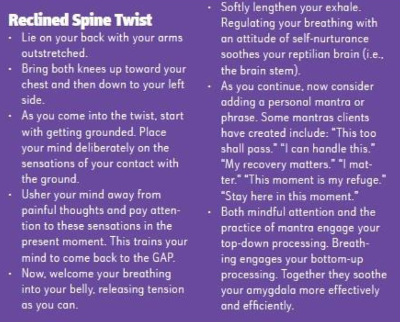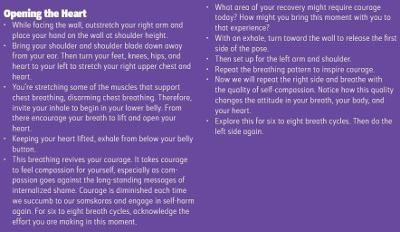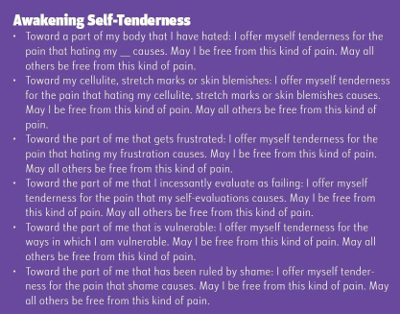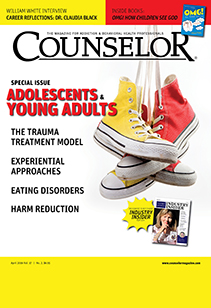LOADING
Share

We sat in a circle, the first night of the weekly Hunger, Hope, and Healing yoga therapy group:
- “I’ve been chubby since I was a kid. Everyone criticized me, including my parents. For fifty-eight years, I’ve hated my body. I’ve turned to food to help me with this hatred, but it doesn’t work. The shame voice only goes away for a moment.”
- “I’ve tried everything. Every diet. Compulsive exercise. Good behavior. Bad behavior. Even when I lost weight, I wasn’t able to be happy in my body. I’ve been on a downward spiral now for months. I don’t know what happened.”
- “I can’t remember a time when I wasn’t asking myself ‘What’s wrong with me?’ I can’t even remember when I started using food like this.”
With the greater visibility of yoga therapy and more treatment centers including yoga, I’m asked daily by students, “How can yoga help me with this?” And, when speaking to counselors, “What is yoga therapy?” and “How might yoga therapy be utilized in helping clients with disordered eating patterns?”
Yoga therapy is a specific field of practice, with deep roots in yoga psychology, physiology, neuroscience, and the practices of asana, pranayama, mindfulness, and meditation. There are two windows through which I look when making recommendations to integrate yoga therapy into existing clinical work. Having facilitated yoga therapy trainings approved of by the American Psychological Association, I am sensitive to the guidelines for and context in which clinicians are working, including inherent space limitations. Additionally, I often collaborate as a member of clients’ treatment team, where I conduct yoga therapy.
The Pancha Maya Model
A foundational strength in yoga therapy is our view of the human condition and its indwelling potential. One approach, called pancha maya, outlines our human experience in five layers. These layers provide a road-map for the inward journey of recovery as well as providing hopeful, manageable, and tangible tools for clients.
Layer Five
The most indwelling of the koshas, called anandamaya kosha, is our native radiance and wholeness. Here we experience unconditional belonging and love. This essential nature cannot be distorted by pain, trauma or the ways that pain or trauma compromise our self-image or self-worth. It is not diminished by the behavior strategies that we develop to help us navigate the pain of such wounds.
Layer Four
Moving outward from ananda, vijnanamaya kosha is the layer from where wisdom and intuition arise. It is here that our connection with this unconditional belonging and love can be obscured by nonnurturing or negative conditioning. Rather than experiencing our intuition or insight as trustworthy, we may dull it, decide it isn’t trustworthy or suppress it when our biological survival instinct tells us that our intuition could threaten our safety in relationship to those on whom we are dependent. Much of this occurs when our brains are younger, more vulnerable to shaping, and highly dependent on others for our basic survival. We learn to doubt our body’s innate intelligence. Those struggling with disordered eating patterns doubt and distrust their intuition, their body, their appetites, their cravings, and their hunger and satiation signals. Trusting their body’s wisdom to endure the processes of recovery can be hindered by years of restriction, bingeing, purging, and compulsive exercise. Yoga’s effect on the body, the mind, and the brain reawakens clients’ relationships to their intuition, self-trust, their confidence in their body-intelligence, and their faith in themselves to navigate the terrain of recovery.
Layer Three
The middle layer, manamaya kosha, houses our mental impressions and strategies, and is conditioned by both nurturing and nonnurturing experiences. Herein lays what yoga refers to as “samskaras”: deeply grooved mental patterns that become our narratives. These are the thought habits, mental strategies, and the source of the mind-body disconnection so pervasive with disordered eating patterns. When such seemingly stubborn, impenetrable, yet distorted impressions arise—such as with body image dysmorphia, internalized shame, perfectionism, compulsivity, and obsession—they cloud the vijnanamaya and anandamaya koshas. Light doesn’t shine well through murky or disturbed water. Yet, when light penetrates clear water, its brilliance will shine through. As a yoga therapist I aim to help my clients experience this shining and to reexperience their indwelling radiance and wisdom by offering tools that support mental clarity and openness.
Layer Two
The second layer, pranamaya kosha, is the respiratory, circulatory, and nervous system. It connects the mind (mana) and body (anna). Understanding the role of breathing and the artistry of the nervous system is essential to healing—all healing, not just disordered eating recovery—and a significant aspect of the yoga therapist’s tool kit. In response to what’s occurring at the manamaya kosha, clients’ nervous systems and breathing patterns will reflect anxiety, restlessness, depression, dis-ease, chronic pain, fatigue, fear, compulsivity, and digestive, endocrine, and immune system dysregulation.
Driven by brain and body systems geared for our biological survival, a distressed manamaya kosha (such as with PTSD) disrupts the nervous system’s ability to function intelligently, smoothly, and with consideration for long-term health and vitality. Clients may develop hyper- or hypovigilant nervous systems, choosing sympathetic (fight or flight) or dorsal vagal parasympathetic (freeze or collapse) strategies that prioritize safety and survival. When these strategies are developed enough, via acute or escalated experiences as well as long-term reliance on such strategies, clients’ nervous systems can become one of the significant blocks to their recovery. The system says it’s protecting them and will do so even against the wisdom of recovery until skillful, compassionate, body-centered, nervous-system-sensitive, and relationally-attuned therapeutic tools are available.
Layer One
The outermost layer, annamaya kosha, the physical body, is where our disordered eating behavior clients may feel their struggles lie. If only they could control their physical body with its appetites (both food and otherwise), its aches and pains, its need for rest and movement, and its shape, composition, and weight. There is an accompanying dissociation from, anger toward, and objectification of their body. This sense of separateness enables the self-hatred, instigates the efforts at control and body dominance, fuels the despair over loss of control, and proliferates the chronic obsession with their disordered eating patterns.
What This Means
Though we make initial efforts to provide relief to the physical body, we understand that the symptoms manifest there, but have deeper roots in our mental impressions and strategies. The pancha maya model tells us that the respiratory, circulatory, and nervous systems are more powerful than the physical body, and that our mental impressions and strategies are more powerful yet. Fortunately, the layers of the koshas have reciprocal relationships: if we can provide relief for the physical body, we often provide relief for the mind and our mental impressions. Lessening those painful mental impressions—such as inner shame and disordered eating thinking—likewise provides relief toward the physical body, and reawakens connection in our layer where wisdom and intuition are and the layer where our native radiance and wholeness resides.
With this understanding, we can begin to map out a full recovery of our clients; working with their body, mind, and emotional well-being.
Getting in the GAP
Getting in the GAP is an essential life skill that I utilize with my eating disordered clients. GAP stands for getting grounded, paying attention, and becoming present. Here is an example:
- Choose an object for getting grounded.
- Repeatedly direct attention to this one tangible event. For moments when mind habits intrude, without judgment, simply usher attention back to the object of grounding.
- Continue as you train yourself in becoming present.
Annamaya Kosha: Tools for the Physical Body
Since the annamaya kosha (physical body) experiences itself in an environment, not in isolation, we start with a technique for getting oriented to the moment, in the body, in the context of life. This includes the couch on which your clients sit and the texture of the floor beneath their feet. Yet, when there is agitation at the deeper koshas, getting grounded in their immediate environment, in the here and now, can represent feelings of significant anxiety for clients, especially if feeling their body or their emotions is frightening. This is also the case if they learned to dissociate from their body and don’t know where to start. We begin mindfulness on neutral sensations from the tangible present moment, as it is, without needing to change or improve anything. Neutral implies sensations we can experience without inciting judgment or reactivity.
Two mindfulness tools include the touchstone and sound and the space in which sound exists.
The touchstone can be helpful for clients who tend to soar off into emotional despair, become easily ungrounded or feel overwhelmed by recovery. Bringing attention to the places where we are right now, connected to the ground beneath us in whatever form that takes, trains attention to come down, rather than to soar off. I often use this with my clients on the bulimic spectrum.
Sound can be helpful for clients who tend to isolate, pull inward or collapse into feelings of complacency about their recovery. Sound lifts us into the immediate here and now. Acknowledging the immense space in which all sound exists lifts us into the larger pulse of life. I often use this initially with my clients on the anorexic spectrum.
Cultivating Interoception
Now we utilize Getting in the GAP to go a bit deeper into the body and to cultivate interoception. Interoception is the ability to have an internalized, cohesive, and relational sense of our physiological reality. Interoception allows us to orient and respond to internal body signals such as hunger, thirst, needs for movement, fresh air or rest. It includes awareness of body temperature, breathing, and muscular and visceral sensations. It is a felt sense of our somatic presence in the world.
When clients have years of dissociation or body-centered self-hatred, I anticipate that moving more deeply into their body may be disquieting. An analogy may be the transition we make from snorkeling to scuba diving. Scuba diving requires much more training and skill development. To prevent overwhelming clients, we nudge the experience of the body gently.
I recommend that therapists first demonstrate the yoga practices. Therapists can either do them together or talk their clients through the pose while providing both verbal assurance and appreciation of their efforts. A skill to develop through experience is timing the duration of a yoga pose. With my clients, I encourage them to explore the pose for a minimum of three breaths, offering a less overwhelming start. However, in time, I prefer that they explore the pose long enough for both of us to sense the change created in their body, nervous system, breath, and mind. This may occur with five or six deep, slow diaphragmatic breaths. It may take up to ten. Staying longer can become counter-productive if clients are new to yoga.
.jpg)
Text box 1 illustrates the upward hands pose, a simple practice that develops interoception as well as helps clients to develop a relationship to their body intelligence. All on its own, their body intelligence will bring the sensations back to homeostasis. Observing this occur is one way to consider that their body intelligence is still available to and wants to help care for them.
Pranamaya Kosha: Respiration, Circulation, and Innervation
Neuroscience echoes what yoga has been suggesting: that is, getting grounded, paying attention, and becoming present relieves suffering. Mindfulness changes brain structures, improves resilience, and lessens even long-held mental impressions—those that are deeply tied to past conditioning or trauma. As Getting in the GAP lessens mental agitation, it sets the foundation for taking a body-centered risk: diaphragmatic breathing. Diaphragmatic breathing was our intended baseline as humans. Yet, when the manamayakosha is distressed it will alter breathing patterns to tend to that distress. Done chronically, the body can create conditions such as reverse breathing (abdomen goes in during inhale and out during exhale), chest breathing (both inhale and exhale initiated in the chest) or frozen breathing (small sips of very shallow breathing).
Breathing Interventions
Breathing into the belly can feel profoundly uncomfortable for clients. We use Getting in the GAP to soothe reluctant or apprehensive clients and train them to be willing to belly breathe. Chest breathing, a common result of holding tension in the belly, builds a sense of internal pressure, adversely effects the exhalation, increases heart rate, and tells the brain to be prepared to fight or flee an emergency, perceived or real. A parasympathetic brake applied to this sympathetic activation can be facilitated through shifting the breath to the diaphragm.
.jpg)
Text box two illustrates downward facing dog, which is a very common yoga pose. It lengthens the spine, releases upper back and neck tension, stretches the hips and legs, and, most importantly, it promotes diaphragmatic breathing. This variation is done with a desk or table to make it suitable to a counseling session.
With every breath cycle, the sympathetic nervous system is activated during inhalation and the parasympathetic nervous system during exhalation. Diaphragmatic breathing with a longer exhale invites the relaxation response toward a baseline for the ventral vagal parasympathetic response for health and homeostasis. Chest breathing and a shorter exhale, generate the sympathetic response. Frozen breathing can generate, and be generated by, the dorsal vagal parasympathetic response. Together, clients and practitioners can practice this technique. It can feel awkward to have only the client doing the breathing while the therapist is watching. And, the technique can benefit both. If clients can’t approximate this while sitting, a simple desk-based, forward bend technique with the head resting on the back of the hands will initiate diaphragmatic breathing. Here’s an example of how this should work:
- Place one hand on your belly and one hand on your heart.
- Resist your mental chatter and bring your attention to your breathing.
- As you inhale, the diaphragm moves down to draw air into the lungs. The abdomen moves out slightly.
- As you exhale, the abdomen tones and moves in toward the spine, bringing the diaphragm back up toward the ribs.
- As you pay attention to your breathing, lightly count both inhale and exhale. Encourage your smooth exhale to be two paces longer than your inhale.
- Do this for six to eight breath cycles.
- You may also do this lying down in bed at night to help promote sleep, or using the desk position when you need a mental refresher during the day.
Getting Comfortable Feeling Uncomfortable
Getting Comfortable Feeling Uncomfortable (GCFU) is another essential life skill for eating disordered clients. At some point in life, all of us will struggle with feeling uncomfortable. For these specific clients, the internalized shame of disordered eating patterns is very uncomfortable. Chronic calorie restriction is uncomfortable. Eating to the point of bloating and pain is uncomfortable. Self-hatred is uncomfortable. So why not get comfortable feeling uncomfortable?
Let’s explore two considerations for GCFU.
Tolerance
Discomfort is an opportunity to grow, yet we divert ourselves with strategies to alleviate the discomforts we specifically don’t know how to tolerate. All of my clients have made themselves very uncomfortable. Through yoga therapy, they’ve come to learn that along the way they preferred this familiar self-generated discomfort to the “other” discomforts. Recovery requires clients to tolerate these “other” discomforts: uncomfortable feelings, including sensory events, body sensations such as hunger and satiation, and emotions. They practice coexisting with their discomfort long enough to learn that sensations and feelings provide information, and are ever-changing and ephemeral; not inducing numbing or self-harm allows them to surf the discomfort with curiosity and to learn from it; and developing this skill is empowering, increases their resilience, and widens their bandwidth for the kinds of discomforts that help them to grow.
Growth
The discomforts associated with growth, feeling joy, contentment or optimism are also important for practicing GCFU. My clients are often surprised that just as they start to feel hopeful or elated, they then feel terrified. We practice GCFU in those moments and learn to acclimate to new levels of personal joy and compassion.
Manamaya Kosha: The Senses, Mental Habits, and Personal Narrative
Every moment our senses take in information from the world around and within us. In a flash our brain interprets the information and we are prompted to react or respond. While clients may be highly functioning in their lives, when their brain is triggered by certain sensory events, they lose control. Seeing or smelling certain foods can lead to painful overindulgence. Feeling too full, too hungry, too tired or too cold can lead to dysregulation of their brain and body, instigating a binge, purge or restriction behavior.
When a certain thought, memory or interpersonal stimulus occurs, clients may be flooded by a shame storm. Their brain literally sends emergency messages asking for relief-oriented actions. What has provided pseudo-relief historically becomes the go-to. This creates the samskaras, the deeply grooved mental pathways that become addictions and compulsions.
Real relief is available.

Text box 3 describes a simple practice that done regularly can transform clients’ relationships to difficult sensations. This meditation also offers a diversion when unhealthy temptation or compulsion are lurking. Practiced for this purpose we call it a “yoga intervention”; we’re intervening on a samskara.

Once a shame-inducing thought arises and the brain is high-jacked by its emergency survival systems, clients need to know how to soothe and then resource their brain for wise action. Text box 4 is an exercise that illustrates how clients can learn to calm the brain when it is experiencing pain.
We’re each born with a certain threshold for discomfort as well as levels of personal buoyancy, equanimity, joy, and resilience. Higher vagal tone correlates with higher ability to tolerate distress and a greater sense of personal buoyancy, and vice versa. Trauma and addiction affect vagal tone. So does healing.

Vagal tone is also associated with our innate capacity for compassion, altruism, and benevolence. Most of my clients are challenged to express compassion for themselves, though they will generously extend it to another group member. Text box 5 describes an exercise for reviving courage and self-compassion.
Vijnanamaya Kosha and Anadamaya Kosha
The last practice we’ll explore reconnects clients to their vijananmaya and anandamaya koshas. There is a natural wisdom to self-tenderness—our ability to offer tenderness toward ourselves—rather than pitting us against ourselves, as shame and self-hatred do. Tenderness supports our innate needs for empathy, attachment, and connection. As self-tenderness soothes a distressed manamaya kosha, it returns us to our vijanamaya kosha, where intuition and wisdom become available. Self-tenderness also opens our hearts toward our shared humanity and brings us back home to our original and unconditional belonging and love, anandamaya kosha.

The practice of “Awakening Self-Tenderness” is initially directed toward clients (from themselves) and to the ways in which self-hatred has overwhelmed their self-tenderness. It then ripples out to others. Clients will find their compassion and sense of interconnection and belonging growing. This exercise is found in text box 6.
Conclusion
Change and recovery can happen for our clients. On the last night of our eight-week yoga therapy group, we sit together.
- “I no longer believe my shame voice. Not only is it not helpful, it’s not truthful. I am amazed that I can be compassionate with myself after all these years.”
- “I am proud of myself for learning to nurture me! I now take the time to breathe, hydrate, stretch, and to be kind toward my body and my brain. Thank you.”
- “I do feel more courageous. It’s amazing after being numb for so many years. I was afraid to try again. I believe in myself more.”









 Counselor Magazine is the official publication of the California Association of Addiction Programs and Professionals (CCAPP). Counselor offers online continuing education, article archives, subscription deals, and article submission guidelines. It has been serving the addiction field for more than thirty years.
Counselor Magazine is the official publication of the California Association of Addiction Programs and Professionals (CCAPP). Counselor offers online continuing education, article archives, subscription deals, and article submission guidelines. It has been serving the addiction field for more than thirty years.